 W
WThe 12-pounder Whitworth rifle was a medium caliber field gun deployed during the mid-19th century. Designed by Joseph Whitworth, the gun was most notably used during the American Civil War. The gun was also used by the Imperial Brazilian Army in the War of the Triple Alliance.
 W
WThe 32-pounder guns were sets of heavy-caliber pieces of artillery mounted on warships in the last century of the Age of sail.
 W
WThe 68-pounder cannon was an artillery piece designed and used by the British Armed Forces in the mid-19th century. The cannon was a smoothbore muzzle-loading gun manufactured in several weights, the most common being 95 long cwt (4,800 kg), and fired projectiles of 68 lb (31 kg). Colonel William Dundas designed the 112 cwt version in 1841 and it was cast the following year. The most common variant, weighing 95 cwt, dates from 1846. It entered service with the Royal Artillery and the Royal Navy and saw active service with both arms during the Crimean War. Over 2,000 were made and it gained a reputation as the finest smoothbore cannon ever made.
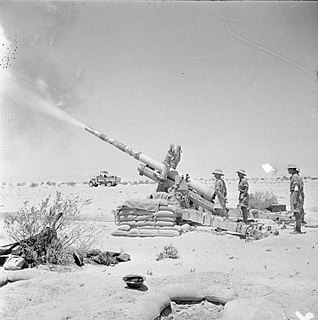 W
WThe BL 4.5 inch medium gun was a British gun used by field artillery in the Second World War for counter-battery fire. Developed as a replacement for the BL 60-pounder gun it used the same carriage as the BL 5.5-inch medium gun but fired a lighter round a further distance.
 W
WThe BL 5.5-inch gun was a British artillery gun introduced during the middle of the Second World War to equip medium batteries.
 W
WThe Ordnance BL 6 inch 30cwt howitzer was a British medium howitzer used in the Second Boer War and early in World War I. The qualifier "30cwt" refers to the weight of the barrel and breech together which weighed 30 hundredweight (cwt) : 30 × 112 lb = 3,360 lb. It can be identified by the slightly flared shape of the muzzle and large recuperator springs below the barrel.
 W
WThe BL 6 inch gun Mk V was an early Elswick Ordnance Company breech-loading naval gun originally designed to use the old gunpowder propellants. They were used for coast defence around the British Empire.
 W
WThe 24 cm Mörser M 98 was a heavy siege howitzer used by Austria-Hungary during World War I. It was designed to attack modern fortifications, but its short range and ineffective ammunition led to the development of the more deservedly famous 30.5 cm Mörser M 11 and M 16.
 W
WThe Ordnance BL 10 pounder mountain gun was developed as a BL successor to the RML 2.5 inch screw gun which was outclassed in the Second Boer War.
 W
WThe Ordnance BL 12-pounder 6 cwt was a lighter version of the British 12-pounder 7 cwt gun, used by the Royal Horse Artillery in the late 19th and early 20th centuries.
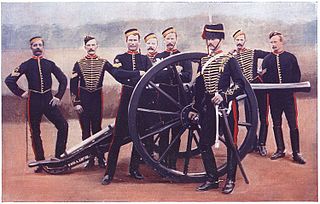 W
WThe Ordnance BL 12-pounder 7cwt was the British Army's field gun, which succeed the RML 13-pounder 8 cwt in 1885.
 W
WThe Ordnance BL 15-pounder, otherwise known as the 15-pounder 7 cwt, was the British Army's field gun in the Second Boer War and some remained in limited use in minor theatres of World War I. It fired a shell of 3-inch diameter with a maximum weight of 15 pounds (6.8 kg), hence its name which differentiated it from its predecessor '12-pounder' 3-inch gun which fired shells weighing only 12.5 pounds (5.7 kg).
 W
WThe first usage of cannon in Great Britain was possibly in 1327, when they were used in battle by the English against the Scots. Under the Tudors, the first forts featuring cannon batteries were built, while cannon were first used by the Tudor navy. Cannon were later used during the English Civil War for both siegework and extensively on the battlefield.
 W
WThe Royal Navy's field gun competition is a contest between teams from various Royal Navy commands, in which teams of sailors compete to transport a field gun and its equipment over and through a series of obstacles in the shortest time. The competition evolved during the early years of the 20th century. The "Command" format, negotiating walls and a chasm, was held annually at the Royal Tournament in London from 1907 until 1999, apart from the periods during the World Wars. The "Inter-Port" or "Command" Competition was contested by teams from the Royal Navy annually, and was a popular item at the Royal Tournament until finishing in 1999.
 W
WThe L118 Light Gun is a 105 mm towed howitzer. It was originally produced for the British Army in the 1970s and has been widely exported since, including to the United States, where a modified version is known as the "M119 howitzer".
 W
WLong Cecil is a cannon built in the workshops of the De Beers mining company in Kimberley for use by the British in the Siege of Kimberley during the Second Boer War.
 W
WThe number 106 fuze was the first British instantaneous percussion artillery fuze, first tested in action in late 1916 and deployed in volume in early 1917.
 W
WThe QF 4 inch Mk V gun was a Royal Navy gun of World War I which was adapted on HA mountings to the heavy anti-aircraft role both at sea and on land, and was also used as a coast defence gun.
 W
WThe QF 6-inch 40 calibre naval gun (Quick-Firing) was used by many United Kingdom-built warships around the end of the 19th century and the start of the 20th century.
 W
WThe Ordnance QF 12-pounder 8 cwt was a Royal Navy "landing gun" intended for navy use ashore. "8 cwt" refers to the weight of the gun and breech, approximately 8 cwt = 8 x 112 lb (51 kg) = 896 lb (406 kg). This was how the British often differentiated between guns of the same calibre or weight of shell. This gun had a short barrel and was of relatively low power compared to the 12 pounders of 12 and 18 long cwt, although it fired the same shells.
 W
WQueen Elizabeth's Pocket Pistol is a cannon built in 1544 in Utrecht by Jan Tolhuys, before Elizabeth I came to the throne. The gun was presented to Henry VIII by Maximiliaan van Egmond, Count of Buren and Stadtholder of Friesland as a gift for his young daughter Elizabeth.
 W
WThe L21A1 RARDEN is a British 30mm autocannon used as a combat vehicle weapon. The Royal Armament Research and Development Establishment (RARDE) and the Royal Small Arms Factory (RSAF), Enfield, at the time, were both part of the Ministry of Defence.
 W
WThe Armstrong Breech Loading 12 pounder 8 cwt, later known as RBL 12 pounder 8 cwt, was an early modern 3-inch rifled breech-loading field gun of 1859.
 W
WThe Armstrong Breech Loading 20-pounder gun, later known as RBL 20-pounder, was an early modern 3.75-inch rifled breech-loading light gun of 1859.
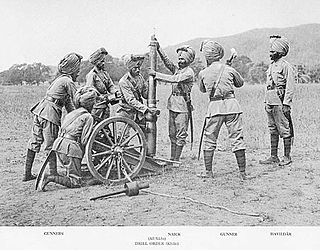 W
WThe Ordnance RML 2.5-inch mountain gun was a British rifled muzzle-loading mountain gun of the late 19th century designed to be broken down into four loads for carrying by man or mule. It was primarily used by the Indian Army.
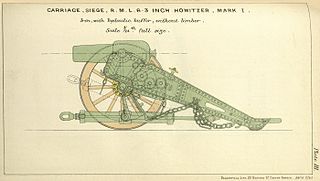 W
WThe RML 6.3-inch howitzer was a British rifled muzzle-loading "siege" or "position" howitzer/mortar proposed in 1874 and finally introduced in 1878 as a lighter version of the successful 8-inch howitzer that could be carried by the existing 40-pounder gun carriage.
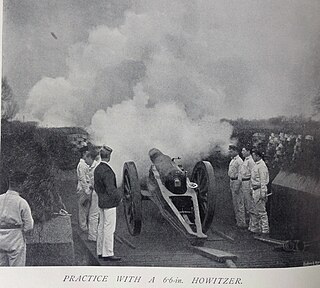 W
WThe RML 6.6 inch howitzer was a British Rifled, Muzzle Loading (RML) Howitzer manufactured in England in the 19th century, which fired a projectile weighing approximately 100 pounds (45 kg). It was used in siege batteries and in fortifications.
 W
WThe RML 7-inch guns were various designs of medium-sized rifled muzzle-loading guns used to arm small to medium-sized British warships in the late 19th century, and some were used ashore for coast defence.
 W
WThe RML 7-inch guns were various designs of medium-sized rifled muzzle-loading guns used to arm small to medium-sized British warships in the late 19th century, and some were used ashore for coast defence.
 W
WThe Ordnance RML 7-pounder Mk IV "Steel Gun" was a British rifled muzzle-loading mountain gun. 7-pounder referred to the approximate weight of the shell it fired.
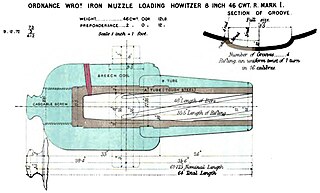 W
WThe RML 8-inch howitzer was a British Rifled, Muzzle Loading (RML) Howitzer manufactured in England in the 19th century, which fired a projectile weighing approximately 180 pounds (82 kg). It was used in siege batteries and in fortifications.
 W
WThe RML 9-pounder 8 cwt gun and the RML 9-pounder 6 cwt gun were British Rifled, Muzzle Loading (RML) field, horse and naval artillery guns manufactured in England in the 19th century, which fired a projectile weighing approximately 9 pounds (4.1 kg). "8 cwt" and "6 cwt" refers to the weight of the gun to differentiate it from other 9-pounder guns.
 W
WThe RML 13-pounder 8 cwt gun was a British Rifled, Muzzle Loading (RML) field artillery gun manufactured in England in the 19th century, which fired a projectile weighing approximately 13 pounds (5.9 kg). "8 cwt" refers to the weight of the gun.
 W
WThe RML 16-pounder 12 cwt gun was a British Rifled, Muzzle Loading (RML) field artillery gun manufactured in England in the 19th century, which fired a projectile weighing approximately 16 pounds (7.3 kg). "12 cwt" refers to the weight of the gun.
 W
WThe 100-ton gun was a 17.72 inches (450 mm) rifled muzzle-loading (RML) gun made by Elswick Ordnance Company, the armaments division of the British manufacturing company Armstrong Whitworth, owned by William Armstrong. The 15 guns Armstrong made were used to arm two Italian battleships and, to counter these, British fortifications at Malta and Gibraltar.
 W
WThe RML 40-pounder gun was a British rifled muzzle-loading siege and fortification gun designed in 1871. It was intended to supersede the RBL 40-pounder Armstrong gun after the British military reverted to rifled muzzle-loading artillery until a more satisfactory breech-loading system than that of the Armstrong guns was developed.
 W
WThe RML 64-pounder 64 cwt gun was a Rifled, Muzzle Loading (RML) naval, field or fortification artillery gun manufactured in England in the 19th century, which fired a projectile weighing approximately 64 pounds (29 kg). "64 cwt" refers to the gun's weight rounded up to differentiate it from other "64-pounder" guns.
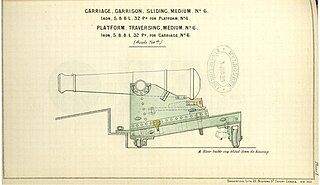 W
W